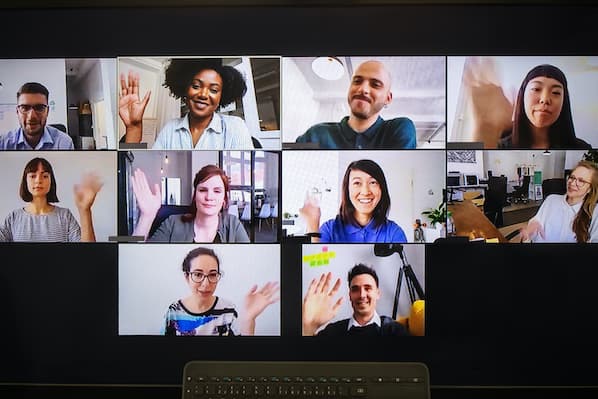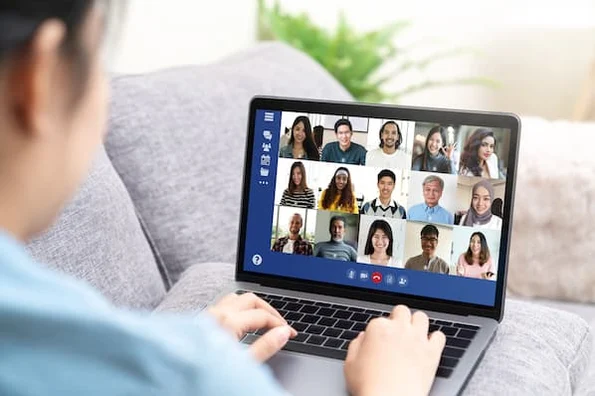Meetings get a bad rap for being unnecessary time-wasters, and, in some companies, they are. There’s a meeting for virtually everything — brainstorming sessions, weekly check-ins, and status updates.
But not all meetings deserve the hate, especially if they’re used at the right times and for the right reasons. Take, for example, all-hands meetings.
These have a special place in the corporate world and can be a productive way to communicate matters relating to the entire organization.
What is an all-hands meeting?
An all-hands meeting, also known as a town hall meeting, is when a company brings together everyone in the organization (e.g., stakeholders, managers, employees) to discuss important topics.
Is everyone required to attend an all-hands meeting? In most cases, yes. The goal is to get everyone on the same page about goals and initiatives. In-person attendance isn’t always necessary, since some town halls are virtual.
The difference between a typical meeting and a town hall?
“All-hands meetings can be less efficient in problem-solving but more effective in keeping the entire company on the same page,” says Will Yang, head of growth at Instrumentl, a business grant platform.
“It depends on the specific goals and objectives of the meeting. For example, a team meeting is more suitable for a particular project update, while an all-hands meeting is better suited for companywide announcements.”
What’s the purpose of all-hands meetings?
The main purpose of an all-hands meeting is to get everyone in the organization on board with the current direction of the company. It’s a prime opportunity to create transparency and alignment across departments.
In many cases, companies use all-hands meetings to share business information, updates, and processes. For example, discussing the impact of an acquisition and merger, or a new volunteering initiative. But town halls don’t just simplify sharing important company news in one go.
According to Vartika Kashyap, chief marketing officer at team collaboration tool Proofhub, all-hands come with other benefits. For example, they can:
-
Promote a feeling of community
-
Foster a collaborative team environment and increase a sense of belonging
-
Encourage teams to work together toward a common objective
-
Create unity around business goals
-
Instill interdepartmental cooperation needed to achieve objectives
So businesses that desire to build trust with their people should consider all-hands meetings.
What’s on an all-hands meeting agenda?
Town halls are large and require a lot of preparation to pull off. Without an agenda, it’s easy to go off track, making the event feel like wasted time.
Prevent this by creating and sharing an agenda in advance. What’s included on the agenda depends on the company and its current state.
For example, Tim Cook, CEO of Apple, used an all-hands meeting last year to discuss pay equity and workplace issues. Then this year, he called another town hall to address the company’s shortfall in holiday revenue.
These meetings can shift topics each time, or stick to a specific range of topics. Having key topics of discussion can help templatize the meetings, making it easier to plan and know what to expect from both sides.
For instance, at ProofHub, all-hands meetings are a vital part of its culture and communication with teams. The objectives in its agenda include:
-
Covering recent financial information from the last month, quarter, year, or season
-
Encouraging agreement on the company’s mission and approach
-
Celebrating the company’s accomplishments and thanking those who helped make it possible
-
Ensuring everyone in the company voices issues and concerns
What your town hall agenda looks like depends on your industry, current events, and what needs to be shared with the entire organization to move forward in unison.
How to run an all-hands meeting
Organizing all-hands meetings is more than just picking a place and time. You must also consider what happens after (e.g., will you share a recording with those who couldn’t attend?). Here are the steps ProofHub takes when planning each session:
-
Selecting a time and day when the majority of the team can attend
-
Choosing a location
-
Creating a schedule
-
Recording the meeting so that others who can’t attend can still hear it
-
Sending a reminder to everyone
The first step is determining how frequently you’ll have them and how long they should be. ProofHub’s town halls are monthly and last about 90 minutes (or a little longer). They use Google Meet to host meetings with virtual workers.
When you’re working with remote workers, you need a reliable tech stack to simplify town hall execution. Krittin Kalra, founder of WriteCream, an AI tool for content writers, uses several.
“Google Docs is great for sharing documents and ideas. Google Hangouts is ideal for broadcasting the meeting for everyone to watch. And the HubSpot Conference Room app is our pick for scheduling the meeting time and other details.”
With your schedule and tools out of the way, focus on who will present and the topics they’ll cover. For example, Caitlyn Parish, founder of wedding shop Cicinia, designates presenters and specific agenda to ensure the meeting runs smoothly. At the all-hands meeting, she provides company updates, while the heads of different departments share more specific updates related to their teams.
How to ensure productive town hall meetings
Town halls shouldn’t be lectures. If employees feel they’re being talked at, odds are they’ll tune out and disengage. This turns your all-hands into a your-hands meeting.
How do you avoid it? By promoting two-way dialogue.
“To ensure our all-hands meetings are productive, we have a strict agenda with time limits for each topic discussed,” says Yang. “We always have an open Q&A session to encourage participation and transparency. We also try to mix up the format by incorporating team updates, company trivia, or information on new customers.”
By creating a time slot for a Q&A session, you open the floor for your employees to be heard. This is the opportunity to discuss important matters surrounding the meeting’s topics.
How to make an all-hands meeting interesting
Meetings and fun don’t usually go hand in hand. But this doesn’t mean you can’t try to make them interesting. Doing so improves engagement and attendance to get the most out of each session.
So what are some ways to make your town halls less stuffy, while still being valuable?
Here are several tips gathered from Kashyap, Yang, and Kevin Wang, co-owner of Inyouths LED Mirrors:
-
Change locations occasionally (e.g., working lunch or off-site meetings at a fun venue)
-
Use a mix of informative updates and interactive elements (e.g., recognizing employee achievements)
-
Encourage employees to submit questions or discussion topics in advance
-
Include compelling visuals to show company achievements (e.g., slides and videos)
-
Ensure a diverse group of presenters to keep meetings fresh and dynamic
-
Ask lighthearted icebreaker questions and send it in advance
-
Start meetings with a 10-minute celebration of accomplishments since the last meeting (including nonbusiness achievements like marriage, big moves, engagements, and milestones)
-
Give each department 3-5 minutes to discuss something noteworthy or new (e.g., updates on ongoing projects/initiatives)
-
Allow 5-10 minutes for breakout sessions (smaller group discussions)
All-hands meetings don’t have to be a drag. With intentional planning and the right tools, you can create all-hands meetings that are engaging, productive, and possibly even fun.
What did you think of this article?
Meetings











![Do You Really Need to Hold That Meeting [Quiz + Tips]](https://53.fs1.hubspotusercontent-na1.net/hubfs/53/time-wasted-meetings-data_2.webp)


